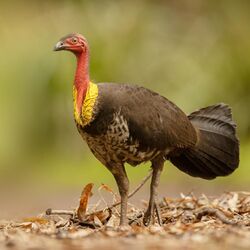Biology:Pangalloanserae
From HandWiki
Short description: Clade of birds
| Pangalloanserae | |
|---|---|

| |
| Australian brushturkey (Alectura lathami) | |
| Scientific classification | |
| Domain: | Eukaryota |
| Kingdom: | Animalia |
| Phylum: | Chordata |
| Class: | Aves |
| Infraclass: | Neognathae |
| Clade: | Pangalloanserae Gauthier and de Queiroz, 2001 |
| Subgroups | |
| |
| Synonyms | |
|
Pananatophasianae | |
Pangalloanserae is a clade of birds defined in a 2001 study by Jacques Gauthier and Kevin de Queiroz as "most inclusive clade containing Galloanserae but not Neoaves". It contains crown Galloanserae as well as all stem-galloanserans.[3][4]
References
- ↑ Field, Daniel J.; Benito, Juan; Chen, Albert; Jagt, John W. M.; Ksepka, Daniel T. (March 2020). "Late Cretaceous neornithine from Europe illuminates the origins of crown birds". Nature 579 (7799): 397–401. doi:10.1038/s41586-020-2096-0. ISSN 0028-0836. PMID 32188952. Bibcode: 2020Natur.579..397F. https://www.repository.cam.ac.uk/handle/1810/303639.
- ↑ Kuhl., H.; Frankl-Vilches, C.; Bakker, A.; Mayr, G.; Nikolaus, G.; Boerno, S. T.; Klages, S.; Timmermann, B. et al. (2020). "An unbiased molecular approach using 3'UTRs resolves the avian family-level tree of life.". Molecular Biology and Evolution 38: 108–127. doi:10.1093/molbev/msaa191. PMID 32781465.
- ↑ Gauthier, Jacques; de Queiroz, Kevin (2001). "Feathered Dinosaurs, Flying Dinosaurs, Crown Dinosaurs and the Names "Aves"" (in en-US). New Perspectives on the Origin and Early Evolution of Birds: Proceedings of the International Symposium in Honor of John H.Ostrom. http://repository.si.edu/xmlui/handle/10088/4690.
- ↑ Field, Daniel J.; Benito, Juan; Chen, Albert; Jagt, John W. M.; Ksepka, Daniel T. (March 2020). "Late Cretaceous neornithine from Europe illuminates the origins of crown birds" (in en). Nature 579 (7799): 397–401. doi:10.1038/s41586-020-2096-0. ISSN 1476-4687. PMID 32188952. Bibcode: 2020Natur.579..397F. https://www.nature.com/articles/s41586-020-2096-0.
Wikidata ☰ Q88077133 entry
 |

